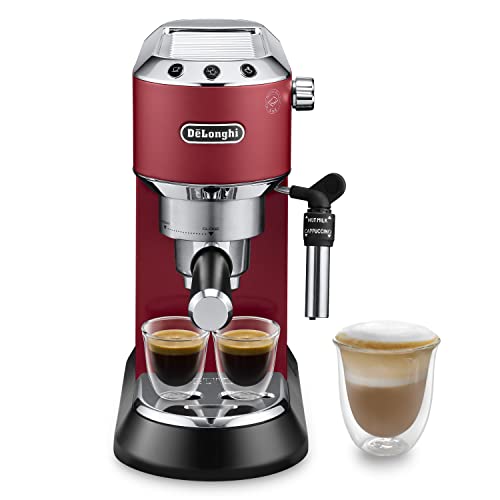Espresso Maker - A Must-Have For Home Baristas
Espresso is a dark, strong beverage that is created by pushing hot coffee through finely ground coffee grounds that are tightly packed. It is the basis for many popular coffee drinks at the cafe.
A barista, also known as an "espresso maker" is able to control a variety of variables to create a perfect cup. This includes the temperature of water as well as its pressure and how tightly packed the coffee is.
Origins
The espresso machine is a device that uses high pressure to force tiny amounts of water that are close to boiling through finely ground beans. The espresso is stronger, more concentrated and served in smaller cups. This is an excellent choice for those who need a strong cup of espresso but need it fast!
In the 19th century the first espresso machines were invented. At the time, coffee was a huge business but the process of making it took too long. People everywhere were desperate for an instant cup!
In 1884, Angelo Moriondo from Turin created the first coffee machine. It held a name that read "New steam machine for the economical and instantaneous brewing of coffee beverages Method A. Moriondo."
The Milanese makers Luigi Bezzerra and Desiderio Pavoni modified and improved this machine. They introduced the portafilter as well as multiple brewheads, as well in other innovations that are still in use with espresso makers today. Their machine was called the Ideale and it was awe-inspiring to the audience at the 1906 Milan Fair. Nine out of ten Italian homes have Moka Pots. Moka Pot.
Variations
Espresso's flavor is more concentrated than coffee, and it pairs well with milk and other ingredients to create popular coffee drinks like cappuccinos and lattes. Its strong flavor is also evident in recipes for baked goods and even marinades.
There are four primary types of espresso maker including manual levers semi-automatic and automatic and super-automatic machines. Each type uses a different method of extraction of espresso.

A manual lever machine works with a piston that is mechanically operated to press water through the ground. It's a perfect blend of manual control and mechanized consistent. You still need to grind, tamp and pull the shot yourself but there's more control over temperature and pressure.
Moka pots are a different manual espresso maker that functions similar to modern pump-driven espresso machine. In an airtight container, boiling water produces steam. This steam is then directed into a container of ground coffee and through a filter made of metal into the top cup. They're less expensive than a large espresso machine, however they're limited to 1-1.5 bars of pressure, which is lower than the ideal for making espresso.
Ingredients
With a little patience and practice Espresso makers can help baristas at home create cafe-style drinks such as lattes, cappuccinos and flat whites. You can also add flavorful extracts or syrups to espresso shots to create an indulgent drink like the espresso martini.
For a great espresso drink you'll need high-end beans, fresh milk, and sugar. Make sure you choose beans specifically marked for espresso and grind them finely to ensure an even extraction. You can experiment with different roasts to find the one you like the best.
You'll require a burr mill to grind the beans to a uniform texture. The espresso machine is equipped with a portafilter, which stores the grounds, and the tamper, which is used to squeezing the coffee in a tighter way.
You'll also require an espresso set and a steamer to make the silky aerated milk so characteristic of espresso drinks. Certain machines have steam wands built-in making this process easier and quicker. You'll also need to regularly descale your machine that involves running water and vinegar solution through the system.
Techniques
Espresso brewing is based on creating pressure to quickly extract intense flavor from finely ground, dark-roasted coffee that is tightly packed into a 'puck. This method of brewing results in a strong coffee shot called espresso. If espresso is brewed correctly it produces a beautiful crema that is topped with.
Most espresso makers use high pressure water to push through finely ground coffee under intense heat. This differs from the Moka Express, which uses heat to remove coarsely ground coffee. This makes an espresso-like beverage that is diluted in water or milk to make other drinks like cappuccinos or lattes.
While the Moka Express is a basic inexpensive appliance, there are other espresso machines are complicated, expensive, and offer many drink options. The most well-known lever machines are Italian designed and make use of a spring-loaded arm to pour hot water from a cylinder to the portafilter. The barista can alter variables like water temperature and grind size shot-by-shot to get the best results. These machines were essential in bringing espresso to greater prominence across Italy and Europe.
Equipment
An espresso machine that is good be able to extract soluble and non-soluble solids from finely roasted tightly packed coffee. This process is made simpler by the use of pressure and controlled variables, such as temperature and grind size. Then there's the flavor which is influenced by several factors including the beans and the method in which they're handled and made.
There are a variety of espresso machines, however the semiautomatic model is the most well-known. It utilizes an electric pump to stir the water and push it through the grounds. The user can also perform the grinding and tamping. espresso machine black friday are the most affordable, however they're not as reliable as spring pistons or other manual designs.
The lever models which are more expensive include a calibrated cylinder that does all the work. These models are more accommodating than spring pistons, however, they require some skill to operate properly. They typically require some maintenance, which means you have to heat and de-assemble the portafilter and the piston each time.
